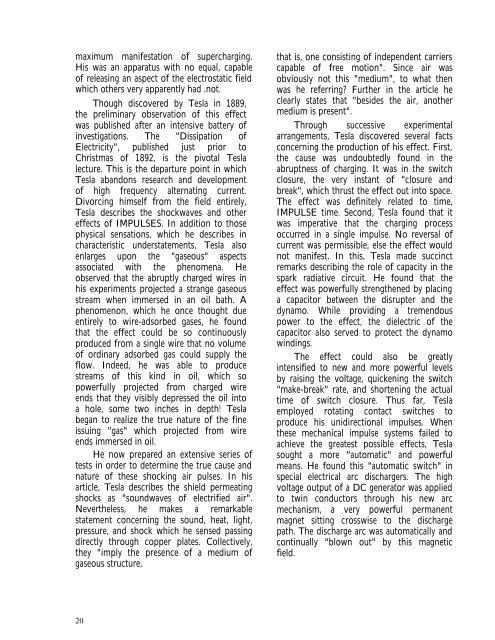Free%20Energy%20Secrets%20with%20Tesla%20patents
Free%20Energy%20Secrets%20with%20Tesla%20patents
Free%20Energy%20Secrets%20with%20Tesla%20patents
Create successful ePaper yourself
Turn your PDF publications into a flip-book with our unique Google optimized e-Paper software.
maximum manifestation of supercharging.<br />
His was an apparatus with no equal, capable<br />
of releasing an aspect of the electrostatic field<br />
which others very apparently had .not.<br />
Though discovered by Tesla in 1889,<br />
the preliminary observation of this effect<br />
was published after an intensive battery of<br />
investigations. The "Dissipation of<br />
Electricity", published just prior to<br />
Christmas of 1892, is the pivotal Tesla<br />
lecture. This is the departure point in which<br />
Tesla abandons research and development<br />
of high frequency alternating current.<br />
Divorcing himself from the field entirely,<br />
Tesla describes the shockwaves and other<br />
effects of IMPULSES. In addition to those<br />
physical sensations, which he describes in<br />
characteristic understatements, Tesla also<br />
enlarges upon the "gaseous" aspects<br />
associated with the phenomena. He<br />
observed that the abruptly charged wires in<br />
his experiments projected a strange gaseous<br />
stream when immersed in an oil bath. A<br />
phenomenon, which he once thought due<br />
entirely to wire-adsorbed gases, he found<br />
that the effect could be so continuously<br />
produced from a single wire that no volume<br />
of ordinary adsorbed gas could supply the<br />
flow. Indeed, he was able to produce<br />
streams of this kind in oil, which so<br />
powerfully projected from charged wire<br />
ends that they visibly depressed the oil into<br />
a hole, some two inches in depth! Tesla<br />
began to realize the true nature of the fine<br />
issuing "gas" which projected from wire<br />
ends immersed in oil.<br />
He now prepared an extensive series of<br />
tests in order to determine the true cause and<br />
nature of these shocking air pulses. In his<br />
article, Tesla describes the shield permeating<br />
shocks as "soundwaves of electrified air".<br />
Nevertheless, he makes a remarkable<br />
statement concerning the sound, heat, light,<br />
pressure, and shock which he sensed passing<br />
directly through copper plates. Collectively,<br />
they "imply the presence of a medium of<br />
gaseous structure,<br />
20<br />
that is, one consisting of independent carriers<br />
capable of free motion". Since air was<br />
obviously not this "medium", to what then<br />
was he referring? Further in the article he<br />
clearly states that "besides the air, another<br />
medium is present".<br />
Through successive experimental<br />
arrangements, Tesla discovered several facts<br />
concerning the production of his effect. First,<br />
the cause was undoubtedly found in the<br />
abruptness of charging. It was in the switch<br />
closure, the very instant of "closure and<br />
break", which thrust the effect out into space.<br />
The effect was definitely related to time,<br />
IMPULSE time. Second, Tesla found that it<br />
was imperative that the charging process<br />
occurred in a single impulse. No reversal of<br />
current was permissible, else the effect would<br />
not manifest. In this, Tesla made succinct<br />
remarks describing the role of capacity in the<br />
spark radiative circuit. He found that the<br />
effect was powerfully strengthened by placing<br />
a capacitor between the disrupter and the<br />
dynamo. While providing a tremendous<br />
power to the effect, the dielectric of the<br />
capacitor also served to protect the dynamo<br />
windings.<br />
The effect could also be greatly<br />
intensified to new and more powerful levels<br />
by raising the voltage, quickening the switch<br />
"make-break" rate, and shortening the actual<br />
time of switch closure. Thus far, Tesla<br />
employed rotating contact switches to<br />
produce his unidirectional impulses. When<br />
these mechanical impulse systems failed to<br />
achieve the greatest possible effects, Tesla<br />
sought a more "automatic" and powerful<br />
means. He found this "automatic switch" in<br />
special electrical arc dischargers. The high<br />
voltage output of a DC generator was applied<br />
to twin conductors through his new arc<br />
mechanism, a very powerful permanent<br />
magnet sitting crosswise to the discharge<br />
path. The discharge arc was automatically and<br />
continually "blown out" by this magnetic<br />
field.












![[Pham_Sherisse]_Frommer's_Southeast_Asia(Book4You)](https://img.yumpu.com/38206466/1/166x260/pham-sherisse-frommers-southeast-asiabook4you.jpg?quality=85)




